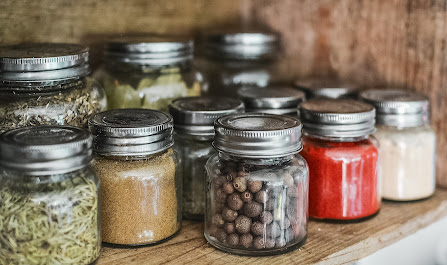COMBINATION OF FOOODS AND HERBS
Good combinations of herbs and foods.
There are limitless ways to use herbs in your cooking. Here are some traditional pairings to get you started:
basil - pesto, tomato sauce, tomato soup, tomato juice, potato dishes, prawns, meat, chicken and poultry, pasta, rice, egg dishes, strawberries
bay leaves: soups, stews, stews, meat and poultry marinades, broths
chili - meat, chicken and poultry, seafood, tomato dishes, curries
chives - salads, chicken, soups, cheese dishes, egg dishes, mayonnaise, vinaigrettes
coriander: Asian dishes, stir-fries, curries, soups, salads, seafood, guacamole
dill - salads, sauces, fish, sour cream, cheese and potato dishes
fennel - fillings, sauces, seafood, salads
garlic: soups, sauces, pasta, meat, chicken, seafood, pesto, salad dressings, bread
ginger - cakes, cookies, Asian dishes
lemongrass: Asian dishes, stir-fries, curries, seafood, soups, tea
marjoram - meat, fish, egg dishes, cheese dishes, pizza
mint - drinks, confectionery, meat, chicken, yogurt, desserts, sauces, vegetable dishes
oregano - cheese dishes, egg dishes, tomato sauce, pizza, meat, stuffing, bread, pasta
parsley - pesto, egg dishes, pasta, rice dishes, salads, butter, sauces, seafood, vegetable dishes
rosemary - fish, poultry, meat, bread, sauces, soups
sage - fillings, tomato dishes, cheese dishes, pumpkin dishes, chicken dishes
tarragon - salad dressing, egg dishes
thyme: soups, bread, chicken and poultry, soups, broths, stews, fillings, butter, cheese, mayonnaise, mustard, vinegar.
Just remember that for health benefits, butters and creams are better reserved for a few times than everyday foods.
an earthy and slightly bitter flavor, and is often used in sausage, stuffing, and dressings. It pairs well with fatty meats, such as pork and duck.
Oregano: This pungent herb has a slightly bitter and spicy flavor, and is often used in Mediterranean and Mexican cuisine. It is a great addition to tomato sauces, pizza, and tacos.
Fresh vs Dried Herbs
When cooking with herbs, it is important to know the difference between fresh and dried herbs. Fresh herbs are more fragrant and flavorful than dried herbs, but they are also more perishable. On the other hand, dried herbs are more concentrated and have a longer shelf life, but they lack the brightness of flavor that fresh herbs have.
Typically, you will use about three times the amount of fresh herbs as dried ones. For example, if a recipe calls for 1 teaspoon of dried oregano, you will use 3 teaspoons of fresh oregano. Keep in mind that dried herbs are more potent, so a little goes a long way.
Pairing Herbs with Food
Herbs can be paired with different types of food to bring out their flavor and aroma. Here are some common pairings:
Basil: Pairs well with tomatoes, mozzarella cheese, and balsamic vinegar.
Rosemary: Pairs well with roasted meats, potatoes, and garlic.
Thyme: Pairs well with poultry, fish, and lemons.
Sage: Pairs well with fatty meats, such as pork and duck, and with sage butter.
Oregano: Pairs well with tomatoes, cheese, and olive oil.
Adding Herbs at the Right Time
When cooking with herbs, it is important to add them at the right time to ensure the best flavor. For delicate herbs, such as parsley and basil, it is best to add them near the end of cooking so that they retain their fresh flavor. Robust herbs, such as rosemary and thyme, can be added earlier in the cooking process to infuse their flavor into the dish.
Storing and Preserving Herbs
Herbs can be stored in a few different ways, depending on whether they are fresh or dried.
For fresh herbs, you can store them in the refrigerator, wrapped in damp paper towels, or placed in a jar with water and covered with a plastic bag. To maximize their shelf life, cut the stems and change the water every few days. Fresh herbs can also be frozen by chopping them and storing them in ice cube trays with oil or stock.
For dried herbs, store them in an airtight container in a cool, dry place. To keep them fresh, avoid exposing them to light and moisture.
In conclusion, herbs are a simple yet effective way to add depth of flavor and aroma to your dishes. Whether you prefer fresh or dried herbs, try incorporating them into your cooking for a delicious and satisfying meal. Experiment with different herbs and food pairings, and discover the endless flavor possibilities that herbs have to offer.
Best regards,
Nimra Rana
Visit our homepage: Active Greenland – Explore latest updates



Comments
Post a Comment